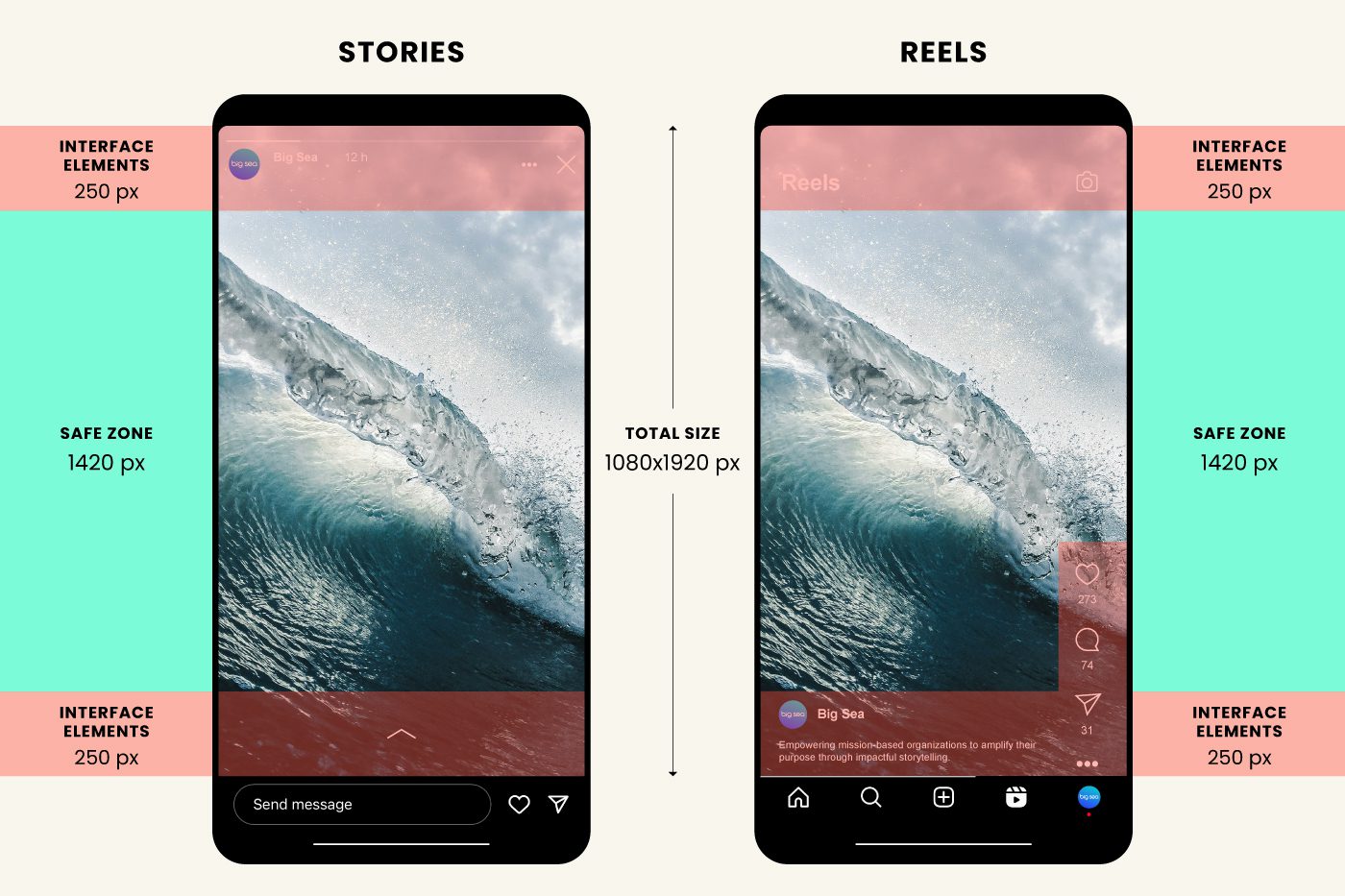Instagram Story Size and Other IG Guidelines
- What is the proper Instagram Story size?
- What is the aspect ratio for Instagram?
- What file types does Instagram support?
- Are Instagram Stories and reels the same size?
- Where can I find free Instagram Story templates?
- Design tips for Instagram Stories
- 1. Keep within the technical specifications
- 2. Stories and Reels are different
- 3. Keep your Story under 15 seconds
- 4. Don't add too much text
- 5. Don't overdo it on hashtags
- 6. Play around with the special features in the app
- Need help with your social media strategy?

A few years ago, the comedian @GarethWaugh posted on Twitter:
“No I don’t watch tiktoks, I watch Instagram reels of tiktok videos that were popular two weeks ago, LIKE A GROWN UP.”
It isn’t just an astute observation about these apps’ demographics and the movement of content through the social media ecosystem. It’s also a reminder that vertically oriented short form video – the kind you find on Instagram Stories and Reels – has taken over social media.
That’s why we’ve put together this guide to posting and properly formatting content for Instagram Stories. All joking aside about elder millennials, the app remains one of the most popular places for creators and brands to reach their followers because of the ease of creating and posting content: you can film and upload vertical videos and images with just a tap. And if you’re all about production values, you can create Instagram content that’s red-carpet worthy too.
What is the proper Instagram Story size?
Because of the vertical formatting, your Story must have an aspect ratio of 9:16. Use 1080 pixels by 1920 pixels for a crisp, high-resolution visual. Within this, there’s something called a “safe zone.” This is a term for the top and bottom 250 pixels of image where elements of the Instagram interface live (like your profile image and the swipe-up feature). Taking safe zones into account, your Story has about 1080×1420 pixels of available real estate.

Following the above guidelines is important to make sure you don’t lose any content: Instagram cannot show other image formats in Stories, so it will crop and downsize your image to force it into the necessary format.
What is the aspect ratio for Instagram?
While Instagram itself can accept any aspect ratio, your Stories and Reels can only be in a 9:16 aspect ratio (the proportion of the width of the image to its height). Within the 9:16 ratio, you can actually use different resolutions: other common 9:16 resolutions are: 720px by 1280 px, which is a good compromise between a high-resolution image and one that won’t take up a ton of space on your phone; and 450px by 800 px, which will upload much faster but might not be as sharp.
What file types does Instagram support?
Instagram supports multiple file types depending on the kind of content. Picture files should be either a jpg or png format, and under 8 MB in size. Videos should ideally be an mp4 under 650 MB, but Instagram can also accept mov or gif files.
There are pros and cons for each file type depending on the content. For still images, JPG files are the most common, and typically balance image quality with file size so that you end up with a beautiful image that won’t completely take over your phone storage. PNG formats prioritize the image clarity (making it good for transparent images, like if you want to add a brand watermark) at the cost of large file sizes.
For videos, while IG can accept .mov/iMovie files, since .mov is an Apple file format, not all IG users will have the ability to play those files. MP4 files are supported on nearly every device, making them a much better choice overall. You can also upload GIFs, but they’ll need to be converted to an mp4 before uploading.
Are Instagram Stories and reels the same size?
Yes, both Stories and Reels should follow the same technical specifications. Both Stories and Reels should have an aspect ratio of 9:16, in either .jpg/.png or .mp4 file format. Check your upload file size as well, since the resolution of your image can push your file size up to the point where Instagram will compress or crop the file.
Where can I find free Instagram Story templates?
If all these numbers and file names sound like a lot, luckily there are many free tools with templates that take aspect ratio, file size, and safe zones into account. Our favorites for Instagram are Canva and DesignWizard; for more, check out our blog on 7 (truly) free graphic design tools.
We like Canva and DesignWizard because they can be used across many kinds of content, including both photos and videos. If you’re in a field like nonprofits or higher education, you probably already wear several hats and don’t need to become a graphic design pro on top of all your other jobs! Enter Canva and DesignWizard, which provide a wide range of templates and drag-and-drop editing, meaning you can focus on developing your ideas and not the number of pixels in the image.
Another good option is Adobe Express (it used to be called Adobe Spark); it’s the free version of Adobe Illustrator.
Design tips for Instagram Stories
If you’re getting started with Instagram Stories, here are a few tips that will help you take full advantage of the format without overwhelming either yourself or your audience.
1. Keep within the technical specifications
Don’t put yourself in the position of creating beautiful content that’s too big to upload! Or worse, filming horizontally and ending up with missing content due to cropping. Remember the 9:16 vertical aspect ratio for Stories and the content safe zones, and check out free templates (or some neat AI-powered video editing tools) if you’d rather not worry about all the technical stuff.
2. Stories and Reels are different
If you’re brand-new to Instagram, there are multiple different kinds of posts to be aware of. The main difference between Stories and Reels is that Reels are short-form videos (under 60 seconds) posted to your page. Stories, on the other hand, are a quick 15 seconds and disappear from your page after 24 hours (unless you add them to your page as a Highlight). Reels are also typically more polished than Stories, which are mostly used as quick behind-the-scenes-type glimpses into your brand.
3. Keep your Story under 15 seconds
A Story is not a novel! (See what I did there?) Keep it short to prevent your viewer from scrolling away before you’re done. Even 15 seconds can feel like a really long time in this day and age; experiment with Story length to see what resonates most with your particular audience.
4. Don’t add too much text
Since Stories are short 15-second clips, too much text will be impossible to read. Instagram is also an image-focused platform; take advantage of the power of visuals to connect with your audience and keep CTAs short and sweet.
5. Don’t overdo it on hashtags
Hashtags are a great way for people to find your content, but adding too many of them can make your post look spammy or inauthentic. Focus on adding a few hashtags that are highly relevant.
6. Play around with the special features in the app
Instagram has a ton of features designed to engage your audience. There are fun overlays like stickers and filters in addition to text elements; there are also more directly-engaging features like polls and quizzes that ask your audience a question. And if you use a poll or quiz in your Story, you can see exactly who has responded, making this basically a free market-research feature!
Need help with your social media strategy?
At Big Sea, we’re experts in crafting a social media strategy that takes advantage of the technical features of Instagram to deliver beautiful content that connects with your audience. Contact us to learn more about how we can help you shine!


